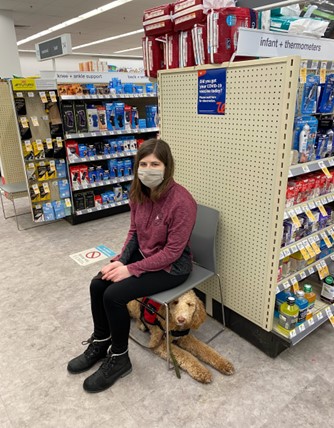
Guest Author: Ellie Martin
Dogs can be a human’s best friend. I mean, what’s not to love right? Dogs offer companionship, provide mental health support, and help us stay active. They can even help us with our daily tasks. According to the Americans with Disability Act (ADA), service dogs are “a dog that is individually trained to work or perform tasks for a person with a disability.” Service dogs can be a great option to consider for people with Ataxia. They can be trained specifically for your individual needs to do things such as:
- Retrieve objects
- Opening doors
- Pressing automatic door buttons
- Turn on lights
- Help with transfers to chairs, beds, or bathtubs
- Brace for help with balance
Stephanie Dube Dwilson says, “Every day, specially trained mobility service dogs help people with balance, strength, or moveability issues live a happy, independent, and fulfilling life.” Service dogs can help people with disabilities live their life freely and with as little stress as possible. These dogs provide companionship and support.
Things to Consider When Getting a Service Dog for Ataxia
To get started, think about what tasks you need help with the most. People who need help with walking may consider a Brace and Mobility support dog. These types of dogs are trained to help with moving from place to place. Brace and Mobility support dogs are fitted with a Mobility Support Harness (MSH), which provides extra balance support and gait stabilization. With the help of a MSH, the handler always has a place to hold on to if needed. The harness can also be helpful with momentum, pulling, leading, and counterbalance.
Organizations vary in the way that they train service dogs, so be sure to research your options before selecting a place that is best for you. Learn from my mistake – I worked with an organization to get a dog, but it did not work out because my needs were different. Familiarize yourself with the process of getting a dog. Some organizations require you to fundraise for your service dog while others are free.
Keep in mind, there are responsibilities that come along with having a service dog, such as: vet and grooming bills, nutrition, daily breaks, and training exercises. Keep this in mind when deciding if a service dog is a good option for you.
Other Benefits to Using a Service Dog for Ataxia
From a physical perspective, dogs can help a lot. But did you know that they can help with mental health as well? According to Psychology Today, using a service dog “improved engagement, interactions, and overall functioning” at work and/or school for people with physical disabilities. People who bring their service dog to their workplace notice improvement of self-confidence and independence. These dogs have been proven to improve people’s mood, including depression, anxiety, and other mental health conditions. Service dogs provide a sense of safety and security, offering you peace of mind and empowering you to become more social. This can increase feelings of independence and happiness.
Finally, having a service dog can help with creating awareness. When people see someone with a service dog, they are more aware that the handler needs more room to get around safely. It can also provide an opening to discuss your condition with others, giving you an opportunity to get proper accommodations.
There is a lot to consider when thinking about getting a service dog. It can take months, or sometimes years. However, I find using a service dog to be a rewarding experience.
Visit www.ataxia.org/general-references for a list of service dog resources.


Disclaimer: Always seek the advice of your physician or other qualified health care provider with any questions you may have regarding a medical condition or treatment and before undertaking a new health care regimen, exercise, treatment, or nutritional supplement.
“Frequently Asked Assistance Dog Questions.” ADA Assistance Dog Registry, assistancedogregistry.com/law_information/. Accessed 2 Feb. 2024.
Dwilson, Stephanie Dube. “Mobility Service Dogs: What Do They Do?” American Kennel Club, American Kennel Club, 24 June 2021, www.akc.org/expert-advice/news/mobility-service-dogs/.
“Mobility Support HarnessTM for Brace and Balance Stability Assistance.” Bold Lead Designs, 23 Jan. 2024, boldleaddesigns.com/shop/mobility-support-harness-for-brace-and-balance-stability-assistance/.
Brace and Mobility Support Dogs: Everything You Need To Know – …, anythingpawsable.com/brace-mobility-support-dogs-complete-guide/. Accessed 2 Feb. 2024.
“Service Dogs May Improve Your Mental Health.” Psychology Today, Sussex Publishers, www.psychologytoday.com/us/blog/finding-a-new-home/202007/service-dogs-may-improve-your-mental-health. Accessed 2 Feb. 2024.
“General References.” National Ataxia Foundation, 9 Nov. 2023, www.ataxia.org/general-references/.
About the Author
My name is Ellie Martin and I have a rare form of Cerebellar Ataxia. I recently graduated from college where I studied rehabilitation services. I wrote this article as a part of a series of blogs to share information I learned along with some personal experiences on the subject.
Read My Past Articles:










